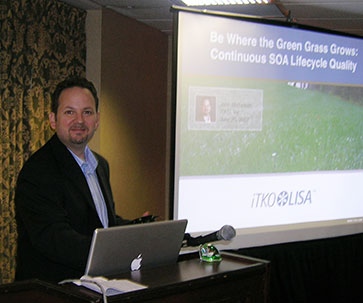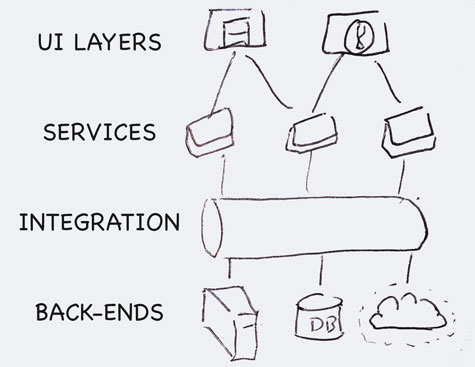People sometimes ask me “what worked?” What made our little
startup ITKO go from 3 guys in an attic in 2004, aiming for a product space
that did not yet exist, to a scrappy Series A company in 2006, to a global enterprise software solution sold into most
of the leading banks and Telcos that was successfully acquired by CA
Technologies in 2011?
A great product, at the right time for the market, grown by smart
leadership, supported and sold through the huge effort of very talented people are par for the
course in any startup success story. There are other pieces of the story I can comment about -- those that
involve marketing strategy and decisions -- and for the first of these I’ll talk
about The Marketing CTO.
For most large firms, the CEO is considered the face of the
company. But in a disruptive software startup, the CTO (or perhaps, a Chief Product/Solution Officer) may be the cult celebrity you need to develop as a
marketing asset, as practitioners of the craft will closely identify with them.
In a small software company, I recommend that at least one-third of the CTO’s
job should be marketing related.
A
software CTO who doesn’t want to be involved with marketing should probably stick to development, services or operations instead.
We were lucky to have a co-founder and CTO in John Michelsen
who had the kind of technical/business mind that would cause customers to perk
up in meetings and ask if they could keep him around for longer. John was great
at holding court in any company’s project room – he was well-informed, genuinely
listened and cared about the success of the people he talked to, and always had
insightful answers.

[John Michelsen at SOAworld 2007, NYC. Photo: me]
Be a Booking Agency
Despite his track record as the smartest guy in the room,
John was not naturally inclined to promoting himself. So the best use of my time
as a marketer was getting John’s passion for better software quality and
automation out to the market as his booking agent for events, and as a personal
scribe for translating his customer anecdotes and advice into blogs and
articles in publications.
What worked best for event placements? Primarily, our best
successes were for topics that clearly answer the question: “If I attend, will
I learn something new that will help me do my job?” If we proposed a topic that
focused on our "LISA 4.x product roadmap," it would never get selected. In the early days,
John was the only presenter attempting to talk about testing the service layer
and back-ends of highly distributed apps, rather than testing solely at the UI
later. It was a new skill everyone wanted to learn at the time, and they could
get it from an inventor in the space. This made him a hit with engineers at
testing conferences as well as the big development and integration vendor shows.
The kicker for getting sessions – and butts in seats at them
– is making sure that the current challenges in that audience’s realm are
listed, and that real customer examples will be included in the session
abstract you send. Customize it per conference. At the very start we didn’t
have that many customers, so John could draw on the experiences of development
and testing projects in many previous gigs that went well, or went awry, to
clarify.
Have a Point-of-View
Early customers of any growing tech company must be able to
confidently bet that they are aligned with that CTO’s vision of not only their
own product, but where the industry as a whole is going. Without a point of
view, customers would basically be signing off on a list of features and
praying that future development continues in their direction.
We’d meet at least once a week to talk about blog or
whitepaper topics, but much of John’s best POV stuff appeared in the form of
reactions to current events – for
instance when software failures that made the headlines. In a 2005 AP story
about a massive crash across multiple airport systems, John was a source for
the reporter and kicked in a quote about developer “nerds who don’t get it”
that sure created some angry rebuttals.
“Mistakes
hurt, but misunderstandings kill … Developers are least qualified to validate a
business requirement. They’re either nerds and don’t get it, or they’re people
in another culture altogether,” said Michelsen, referring to cases where
development takes place offshore.
from 2005 MSNBC.com/Associated Press story
This “nerds” controversy gave us a great opportunity to
follow up by placing our own guest column with an explanation on why John would
make a statement like that, as well as side responses to rebuttals on our own
blog. It’s not enough to express a point of view in some comment or tweet –
some other expert could easily assume credit for it. If your CTO is challenging
the status quo, you must own it by distributing and elaborating on that
message.
Paint a Picture
A CTO who is good in meetings and has a point of view about
where technology is going should be able to paint a picture. A
technical concept without illustration is like a complex assembly manual
without a diagram. It is difficult for the viewer to gain context for their own
situation with terminology alone. There are two ways the CTO must do this –
literal (via whiteboard, usually) and figurative (metaphorically).
Good whiteboarding is perhaps the most essential marketing
tool in the CTO’s kit, as it in essence becomes the story everyone else in the
company should learn to articulate themselves once they get past the elevator
pitch. Don’t worry about making these look like Picasso, in fact, the more
simply executed and repeated they are, the better. Your customer champions
should be able to evangelize the message within their own company. Slick
animated versions of whiteboards might be cool for a high-production brand
video, or a general session of an event, but they are not as believable in
person or online.

See this multi-tier architecture picture [a source from our book, “Service
Virtualization: Reality is Overrated” 2012, Michelsen, English, CA Press]. It is unnecessary to even draw icons, just boxes will do. John would start from the web or mobile application UI and move down the stack, and fill in
the boxes with whatever flavors of application, middleware and back end systems
the customer is working with, and then start pointing out where the constraints or disconnects are occurring in testing and development. (These would likely look more complex today
with the proliferation of cloud, new integration platforms, microservices,
etc.)
An effective and simple whiteboard is the Minimum Viable Product of CTO
marketing – just enough to get the challenges and solution across. Work it out
live, record it, and make sure everyone in your organization can deliver it in
its shortest form. The order in which the boxes are drawn and the way they are described
is as important as the picture itself.
Speaking
Metaphorically …
On the figurative side, the CTO also needs good metaphors in
the bag. We started out with “a test harness for applications,” which borrowed
the idea of plugging in a device to instrument it for testing from the field of
electronics. Pretty good, but not for everyone. Years later John started talking
about “a wind tunnel for applications” like the aerospace and automotive
industries use, which really unlocked the concept of design/test/build in a
controlled virtual environment for everyone. [NASA Wind tunnel image source: WikiCommons.]
.jpg)
You can never capture too many ideas for explaining abstract
concepts to specific audiences in relatable terms: diagnostics/imaging for a
healthcare audience, etc. Even if they don’t work as your main selling message,
metaphors become the headlines for great article bylines and blogs. Snag every one you hear.
The CTO’s point of view also needs to take an expositional
form as a paper that outlines the strategic product vision in better detail. We
called our short paper the “Magna Carta” or I’ve heard it known as the “North
Star” elsewhere.
Don’t be shy. It may be tempting to keep this document
internal – as a trade secret, but you need to have a public-facing version of
it ready for evaluation. The pace of competitive and open source change is so
fast these days that customers need to know where you are going in order to shortlist
your solution, and an advantage kept secret might not remain your advantage for
long.
You’re Deputized,
Podner
There is a very good reason why your CTO should specifically
dedicate time to marketing, and not confuse it with the necessity of sales support, because there only
so many places a CTO can be at once outside of product and management duties.
While there are always some critical deals and partnerships the CTO should help
lock down in face-to-face meetings, you need to consider the value of time spent on marketing as a force multiplier for that critical person. Time spent increasing awareness, attracting customers with the right needs, and
educating new and existing customers to deepen their relationships with your
company pays ever-increasing dividends over time.
Once strategy I’ve seen employed, especially by bigger firms
like Oracle and IBM where the product suite is vast, is to employ a Deputy CTO
to cover many of the marketing demands on the “Sheriff” titled CTO, such as
public speaking appearances, position pieces and partner marketing work. That
is by no means a total answer, but it is a great way to extend the reach of the
CTO office when it is over-extended on work.
The same could be said for encouraging marketing help from
other technical leaders within your company, and its partners. If your CTO is
setting a vision for where the company is going, that should inspire other
leads and engineers who are passionate about that vision to come forward, and
possibly flesh out much more specialized detail for a specific user group,
product or vertical.
If you are in a growing company, seek to develop and fully
utilize the marketing capabilities of your CTO and other technical leaders who
are ready and willing to be thought leaders for your audience.
Seeking mentoring and
assistance in developing the technical leaders in your organization into
powerful marketing evangelists and thought leaders? Contact blueFug Ventures today for a
consultation.